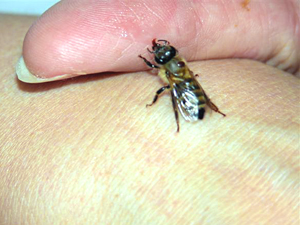There should not have been a large number of diseased bees, because there should not have been very many mites left after the sucrocide treatment we did in August. Just to remind, three times we went into that hive, and sprayed both sides of every frame with a solution that is supposed to crack the shells of the mites, causing them to dry out and die out.
Well, it did not work. Apparently, not even a little. I pulled the board, and there were more than a thousand mites. This is a red-light, sirens-blazing, hugely dangerous infestation. I decided, immediately, that this was a bad re-run of last January on the roof, and the only answer was oxalic acid.
Of course, I'd really hoped not to see such a thing, and had reason not to expect it (having been so proactive the month before), so I had absolutely nothing with me that I could use to take action. So I ran home, called (actually, bleated at) MaryEllen, and she met me back there directly with a hazmat mask and a helping hand.
Of course, I forgot to bring a board for the screened bottom (you have to block off all the openings during treatment) so we scampered down the street to find an election sign to fit the purpose. They work really well because the size is close and the material is designed to be water resistant. On a busy highway median, we found a place where 4 illegal signs (for a Republican) had been placed in close proximity, so we lifted one. (Before anyone screams at me, know that a state highway crew had removed all the others by the end of the day).
So now I don't know what will be with these bees. But wait, there's more!
MaryEllen found out, same day, that some bees she had placed at the mill temporarily were confirmed with a case of American Foul Brood (AFB), a powerful bacterial disease which (in some states) incurs a mandatory order to destroy the colony and fumigate any gear that came in contact with it. So there is a danger of AFB in the remaining colonies at the Mill (including mine) and,if I was not careful, I might have carried it elsewhere as well! This could be just terrible, but more information is needed.
The state bee inspector is coming to look at the Mill colonies next week, and he will let us know if they are infected. My plan, going forward, is to have all the gear that is not currently in use fumigated within the next few weeks, swap out the unfumigated stuff after that, and then fumigate the balance in the Spring. Suits and tools are going into washing machines (with bleach) and dishwashers as is approapriate.
Finally, we were asked to contribute an article to the Mill newsletter, and this is the downhearted gem I sent along.

The Bee Battle for Survival Comes to [the] Mill
By Toni and MaryEllen
For the past two decades, the numbers of beehives and beekeepers has been in decline, and most think this is for two reasons: disease, and the increasing difficulty of preserving the bees against the pests that prey on them. The apiary at [the] Mill is not immune to these forces, and we are fighting to keep the bees strong and healthy enough to winter over.
The main pest that beekeepers think about is the Varroa mite, Varroa destructor, a tiny arachnid that afflicts bees in a way similar to the way a tick can hurt people and dogs (but worse). The Varroa mite jumped to the honeybee from a Southeast Asian bee species that had better defenses: the bee colonies all of us see here now are almost inevitably destroyed if they are left untreated for Varroa.
How does this happen? The mites attach themselves to adult bees, and drink their bee blood (which is bad, a way to spread disease); they also lay their eggs in bee brood cells, and their offspring feed off and maim the young bees (which may be worse). Before long, the adults are weakened, the babies are crippled, and the colony dies.
Earlier in the summer, we applied a newer treatment against Varroa, a product called "Sucrocide," which comes from a tobacco leaf extract . Sucrocide damages the shells of the mites and causes them to dehydrate. It does not damage the bees or leave a chemical residue in the honey, however. For reasons we don't quite understand yet, this treatment does not appear to have worked, and the Cockrill colony (on the right as you face the hill) now has a dangerous infestation. We will therefore be applying at least one more type of treatment over the next few weeks to try to save these bees. We also expect a visit next week from the [...] State Bee Inspector, and he may be able to help us figure out more.
We won't consider using any of the nasty organophosphate chemicals, classic pesticides, in our colonies. Varroa are increasingly resistant to them anyway, and they present the danger of leaving residues in honey and wax,. We use both products in making food and soap, and would not want to expose our families (or anyone else) to them.
As you can see, all the monitoring and treatments that come with the Varroa threat place a lot of stress upon beekeepers, and many of the latter have left this pursuit because it got very hard. At [the Mill], we are lucky to be able to work together when the going gets tough, and we can put our heads together to work out solutions. Neither the bees or the beekeepers can truly go it on their own in this challenging world.
No comments:
Post a Comment